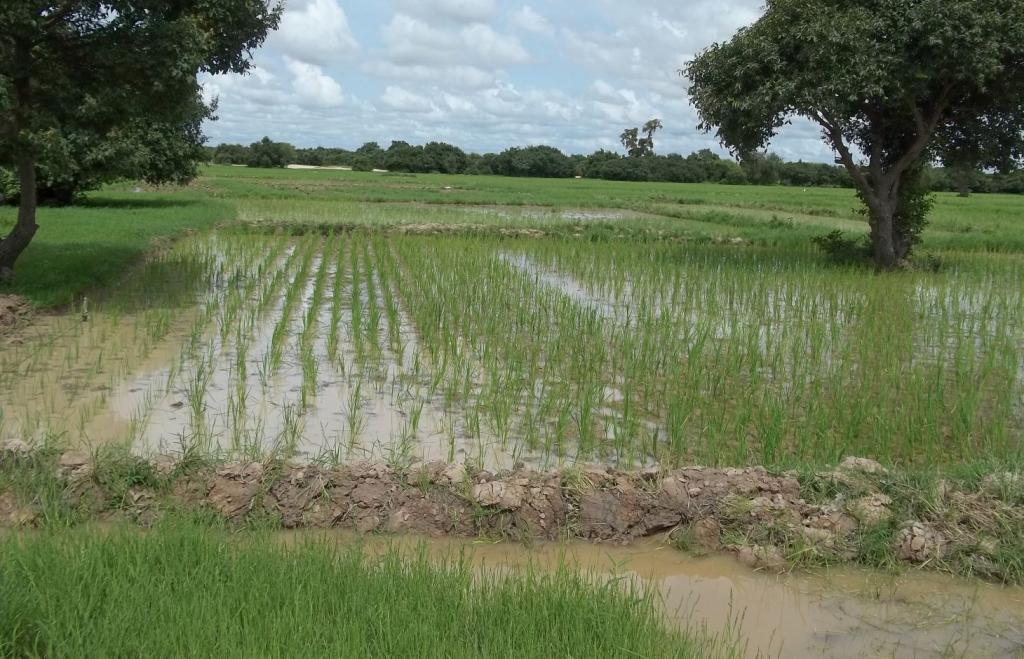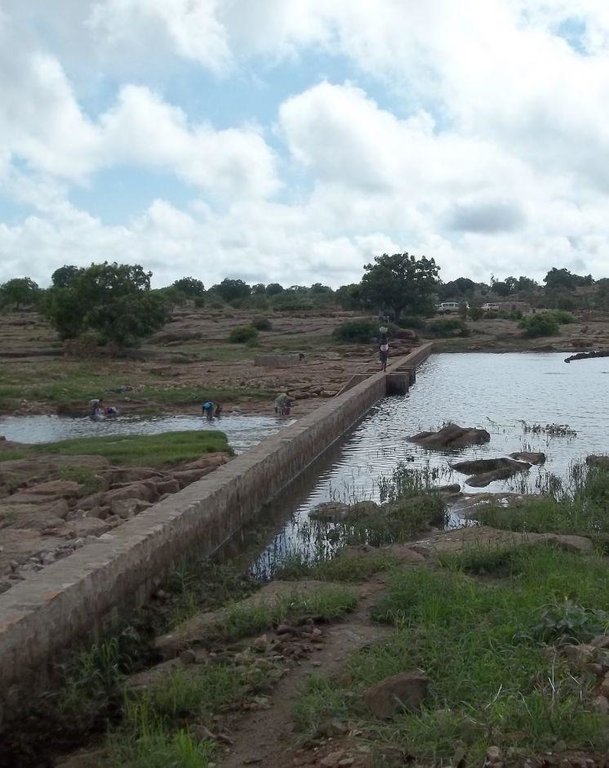Developing lands adjacent to small-scale irrigation schemes [مالي]
- تاريخ الإنشاء:
- تحديث:
- جامع المعلومات: Dieter Nill
- المحرر: –
- المُراجع: Laura Ebneter
Mise en valeur de terres adjacentes à la petite irrigation (French)
approaches_2514 - مالي
عرض الأقسام
توسيع الكل طي الكل1. معلومات عامة
1.2 تفاصيل الاتصال بالأشخاص الرئيسيين لمصدر المعلومات والمؤسسات المعنية بتقييم وتوثيق النهج
متخصص في الإدارة المستدامة للأراضي:
Dako Jean Parfait
parfaitdako@yahoo.fr
Direction Nationale de l'Agriculture (DNA)
مالي
اسم المؤسسة (المؤسسات) التي سهلت توثيق/تقييم النهج (إذا كان ذلك على صلة)
Direction Nationale de l'Agriculture (DNA) - مالياسم المؤسسة (المؤسسات) التي سهلت توثيق/تقييم النهج (إذا كان ذلك على صلة)
Deutsche Gesellschaft für Internationale Zusammenarbeit (GIZ) GmbH (GIZ) - ألمانيا1.3 الشروط المتعلقة باستخدام البيانات الموثقة من خلال WOCAT
متى تم تجميع البيانات (ميدانيا)؟:
01/07/2012
يوافق جامع المعلومات والشخص (لاشخاص) الرئيسي لمصدر المعلومات على الشروط المتعلقة باستخدام البيانات الموثقة من خلال WOCAT:
نعم
2. وصف نهج الإدارة المستدامة للأراضي
2.1 وصف موجز للنهج
Ensure the optimum exploitation of flood recession areas around bodies of water in order to improve agricultural production.
2.2 وصف تفصيلي للنهج
وصف تفصيلي للنهج:
The objective of this practice is to ensure the optimum exploitation of flood recession areas around bodies of water in order to improve agricultural production. This involves using water wisely by choosing suitable crops for the strips of adjacent land.
With this method, it is possible to manage the different water levels around reservoirs. Crops are chosen according to the water level: floating rice for areas where water is deeper; erect rice for moderate depths; and maize, vegetables and trees where surface-water levels are low.
Before the site is developed, farming advisors from the National Directorate of Agriculture (DNA) provide training to growers on benefits, constraints, possible land uses and the operating plan for the land. While the scheme is being built, rural engineering agents inform growers about how to maintain the scheme. Once the scheme is built, the rural engineering service provides training to growers and farming advisors on how to operate the scheme. A village committee is set up to manage the scheme. Committee members must be available and prepared to work in the interest of the community. Crop layouts and land allocations are formalised in an operating plan created consensually with growers. Areas around the reservoir are catalogued and the village council – with the support of technical experts (farming and rural engineering) – then allocate the lands in accordance with the three sections established: the deep section, the moderate-level section and the low-water section. Operation: In collaboration with the growers, the farming advisors set the farming calendar (ploughing, sowing, weeding, etc.) for each of the three sections around the reservoir. The calendar must be adhered to by everyone concerned. The advisors carry out regular monitoring of farming activities and propose corrective measures. The scheme management committee monitors the provision of agricultural inputs, compliance with the operating plan, adherence to the agricultural calendar and the condition of the scheme, and it undertakes repairs when required.
Three essential success factors for managing a reservoir have been identified: the organisation of growers around the scheme to ensure all aspects (infrastructure, lands, water) are well managed; the maintenance of the scheme and reservoir banks (if the banks degrade, the adjacent land may erode or be lost); adherence to the agricultural calendar, which is key for getting the best results from installations.
Village councils participate in the allocation of land to prevent conflicts and ensure compliance with the conditions of the land allocation and the rules in place for the scheme. The management committee ensures the upkeep of the scheme and the supply of agricultural inputs through bulk purchasing. Growers must comply with the agricultural calendar and correctly apply the recommended cropping techniques. Farming advisors train growers, monitor the farming of the site and recommend high-performing and suitable varieties. Rural engineering experts provide training on scheme maintenance, management and monitoring.
2.3 صور عن النهج
2.5 البلد/المنطقة/المواقع التي تم تطبيق النهج فيها
البلد:
مالي
المنطقة/الولاية/المحافظة:
Mali
مزيد من التفاصيل حول الموقع:
Sikasso, Kita, Kati
Map
×2.6 تواريخ بدء وإنهاء تنفيذ النهج
أشر إلى سنة البدء:
2004
2.7 نوع النهج
- قائم على مشروع/برنامج
2.8 الغايات/الأهداف الرئيسية للنهج
The objective of this practice is to ensure the optimum exploitation of flood recession areas around bodies of water in order to improve agricultural production. This involves using water wisely by choosing suitable crops for the strips of adjacent land.
The SLM Approach addressed the following problems: manage the different water levels around reservoirs
2.9 الظروف التي تمكن أو تعيق تنفيذ التقنية/التقنيات المطبقة بموجب النهج
المعرفة حول الإدارة المستدامة للأراضي، والوصول إلى الدعم الفني
- معيق
low exploitation of flood recession areas around bodies of water
Treatment through the SLM Approach: With this method, it is possible to manage the different water levels around reservoirs. Crops are chosen according to the water level: floating rice for areas where water is deeper; erect rice for moderate depths; and maize, vegetables and trees where surface-water levels are low.
3. المشاركة وأدوار الأطراف المعنية
3.1 أصحاب المصلحة المعنيون بالنهج وأدوارهم
- مستخدمو الأراضي المحليون/المجتمعات المحلية
- متخصصون في الإدارة المستدامة للأراضي / مستشارون زراعيون
- الحكومة المحلية
- الحكومة الوطنية (المخططون، صانعو القرار)
- منظمة دولية
3.2 انخراط مستخدمي الأراضي المحليين/المجتمعات المحلية في المراحل المختلفة للنهج
| انخراط مستخدمي الأراضي المحليين/المجتمعات المحلية | حدد من شارك وصف الأنشطة | |
|---|---|---|
| المبادرة/التحفيز | سلبي | |
| التخطيط | سلبي | |
| التنفيذ | تفاعلي | |
| الرصد/التقييم | سلبي | |
| Research | سلبي |
3.4 اتخاذ القرار بشأن اختيار تقنية/تقنيات الإدارة المستدامة للأراضي
حدد من الذي قرر اختيار التقنية/التقنيات التي سيتم تنفيذها:
- متخصصون في الإدارة المستدامة للأراضي بشكل أساسي، بعد التشاور مع مستخدمي الأراضي
اشرح:
Decisions on the method of implementing the SLM Technology were made by mainly by SLM specialists with consultation of land users
4. الدعم الفني وبناء القدرات وإدارة المعرفة
4.1 بناء القدرات/التدريب
هل تم تقديم التدريب لمستخدمي الأراضي / الأطراف المعنيين الآخرين؟:
نعم
حدد من تم تدريبه:
- مستخدمو الأراضي
شكل التدريب:
- في العمل
- اجتماعات عامة
- دورات
المواضيع المغطاة:
Before the site is developed, farming advisors from the National Directorate of Agriculture (DNA) provide training to growers on benefits, constraints, possible land uses and the operating plan for the land. While the scheme is being built, rural engineering agents inform growers about how to maintain the scheme. Once the scheme is built, the rural engineering service provides training to growers and farming advisors on how to operate the scheme.
4.2 خدمة استشارية
هل يملك مستخدمو الأراضي وصولا إلى خدمة استشارية؟:
نعم
حدد ما إذا كانت الخدمة الاستشارية متوفرة:
- في حقول مستخدمي الأراضي
وصف/تعليقات:
Key elements: farming advisors from the National Directorate of Agriculture (DNA) provide training to growers on benefits, constraints, possible land uses and the operating plan for the land, rural engineering agents inform growers about how to maintain the scheme, rural engineering service provides training to growers and farming advisors on how to operate the scheme
4.3 تعزيز المؤسسات (التطوير التنظيمي)
هل تم إنشاء أو تعزيز مؤسسات من خلال هذا النهج؟:
- نعم، باعتدال
حدد المستوى (المستويات) التي تم فيها تعزيز أو إنشاء المؤسسات:
- محلي
حدد نوع الدعم:
- مالي
- بناء القدرات/التدريب
- معدات
4.4 الرصد والتقييم
هل يشكل الرصد والتقييم جزءا من النهج؟:
نعم
التعليقات:
technical aspects were regular monitored by project staff through observations
economic / production aspects were regular monitored by project staff through observations
management of Approach aspects were regular monitored by project staff through observations
provision of agricultural inputs aspects were regular monitored by project staff through measurements
farming of the site aspects were regular monitored by project staff through observations
There were no changes in the Approach as a result of monitoring and evaluation
There were no changes in the Technology as a result of monitoring and evaluation
4.5 البحوث
هل كانت البحوث جزءًا من النهج؟:
نعم
حدد المواضيع:
- علم الاجتماع
- الاقتصاد / التسويق
- علم الايكولوجيا
- تكنولوجيا
5. التمويل والدعم المادي الخارجي
5.2 الدعم المالي/المادي المقدم لمستخدمي الأراضي
هل حصل مستخدمو الأراضي على دعم مالي/ مادي لتنفيذ التقنية/ التقنيات؟:
نعم
5.3 إعانات لمدخلات محددة (بما في ذلك العمالة)
- معدات
| حدد المدخلات التي تم دعمها | إلى أي مدى | حدد الإعانات |
|---|---|---|
| الآلات | ممول بالكامل | |
| أدوات | ممول بالكامل | |
- غير ذلك
| غير ذلك(حدد) | إلى أي مدى | حدد الإعانات |
|---|---|---|
| training | ممول بالكامل |
إذا كان العمل من قبل مستخدمي الأراضي مدخلاً جوهريًا، فهل كان:
- تطوعي
6. تحليل الأثر والتصريحات الختامية
6.1 آثار النهج
هل ساعد النهج مستخدمي الأراضي على تنفيذ وصيانة تقنيات الإدارة المستدامة للأراضي؟:
- لا
- نعم، قليلا
- نعم، باعتدال
- نعم، إلى حد كبير
With this method, it is possible to manage the different water levels around reservoirs. Crops are chosen according to the water level: floating rice for areas where water is deeper; erect rice for moderate depths; and maize, vegetables and trees where surface-water levels are low.
هل ساهم النهج في تمكين الفئات المحرومة اجتماعيا واقتصاديا؟:
- لا
- نعم، قليلا
- نعم، باعتدال
- نعم، إلى حد كبير
Did other land users / projects adopt the Approach?
- لا
- نعم، قليلا
- نعم، باعتدال
- نعم، إلى حد كبير
The practice has been applied in Sikasso Circle (two communes), Kita Circle (two communes) and Kati Circle (one commune). The practice has been applied in over 35 schemes for around 10 years.
Did the Approach lead to improved livelihoods / human well-being?
- لا
- نعم، قليلا
- نعم، باعتدال
- نعم، إلى حد كبير
optimum exploitation of flood recession areas around bodies of water in order to improve agricultural production
Did the Approach help to alleviate poverty?
- لا
- نعم، قليلا
- نعم، باعتدال
- نعم، إلى حد كبير
6.2 المحفز الرئيسي لقيام مستخدمي الأراضي بتنفيذ الإدارة المستدامة للأراضي
- زيادة الإنتاج
- زيادة الربح (القدرة)، وتحسين نسبة التكلفة إلى العائد
6.3 استدامة أنشطة النهج
هل يمكن لمستخدمي الأراضي المحافظة على استدامة ما تم تنفيذه من خلال النهج (بدون دعم خارجي)؟:
- نعم
6.4 نقاط قوة/مزايا النهج
| نقاط القوة/ المزايا/ الفرص من وجهة نظر جامع المعلومات أو غيره من الاشخاص الرئيسيين لمصدر المعلومات |
|---|
| Once good land and water management are assured, the first notable effect is the safeguarding of agricultural activity. As a result of this, agricultural production increases in the villages. (How to sustain/ enhance this strength: When growers demonstrate a strong desire to develop the scheme in this way, its sustainability is guaranteed. Farming advisors are on hand to support growers in the sound exploitation of lands adjacent to reservoirs.) |
| optimum exploitation of flood recession areas around bodies of water in order to improve agricultural production |
| With this method, it is possible to manage the different water levels around reservoirs. Crops are chosen according to the water level. |
7. المراجع والروابط
7.1 طرق جمع/مصادر المعلومات
- زيارات ميدانية، مسوحات ميدانية
- مقابلات مع مستخدمي الأراضي
7.2 المراجع للمنشورات المتاحة
العنوان، المؤلف، السنة، النظام القياسي الدولي لترقيم الكتب ISBN:
Manual of Good Practices in Small Scale Irrigation in the Sahel. Experiences from Mali. Published by GIZ in 2014.
متاح من أين؟كم التكلفة؟:
http://star-www.giz.de/starweb/giz/pub/servlet.starweb
العنوان، المؤلف، السنة، النظام القياسي الدولي لترقيم الكتب ISBN:
Exploitation des petits aménagements hydro-agricoles [Farming small-scale irrigation schemes] (DNA 2011)
الروابط والوحدات المواضيعية
توسيع الكل طي الكلالروابط
لا يوجد روابط
الوحدات المواضيعية
لا يوجد وحدات مواضيعية





